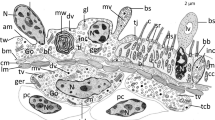Abstract
Temnocephala novaezealandiae (family Temnocephalidae) and Troglocaridicola mrazeki and Scutariella georgica (family Scutariellidae) were studied by electron microscopy in an attempt to reveal characters that would indicate their phylogenetic relationship to other members of the Platyhelminthes. Ultrastructural features of the epidermis in these temnocephaloideans are like those of the neoophoran turbellarians. The epidermis is syncytial, is honeycombed by a multitude of gland necks whose secretions produce an epidermal surface film, and is underlaid by a thick basement membrane. Some cells in the parenchyma are compartmentalized by intrusive cell processes from neighboring parenchymal cells in a fashion similar to parenchymal structure in the Monogenea and Digenea. The spermatozoa have a pair of free 9+1 flagella and contain aligned dense bodies. The Temnocephaloidea is evidently derived from an early rhabdocoel-turbellarian-like ancestor.
Similar content being viewed by others
References
Baer, J.-G., 1953. Temnocéphales. Zoological results of the Dutch New Guinea expedition 1939. No. 4. Zool. Meded., Leiden. 32: 119–139.
Baer, J.-G., 1961. Classe des Temnocéphales. In P.-P. Grassé (ed.), Traité de Zoologie, Tome 3 (Plathelminthes). Masson, Paris: 213–241.
Bresslau, E. & E. Reisinger, 1933. Temnocephalida. In W. Kuekenthal & T. Krumbach (eds), Handbuch der Zoologie. 2: 294–309.
Brooks, D. R., 1967. Higher-level classification of parasitic platyhelminths and fundamentals of cestode classification. In D. F. Mettrick & S. S. Desser (eds), Parasites, their world and ours. Elsevier Biomedical Press, New York: 189–193.
Ehlers, U., 1985. Comments on a phylogenetic system of the Platyhelminthes. This volume.
Halton, D. W., G. P. Morris & A. Hardcastle, 1974. Gland cells associated with the alimentary tract of a monogenean, Diclidophora merlangi. Int. J. Parasitol. 4: 589–599.
Hendelberg, J., 1977. Comparative morphology of turbellarian spermatozoa studied by electron microscopy. Acta. Zool. fenn. 154: 149–162.
Henley, C., 1974. Platyhelminthes (Turbellaria). In A. C. Giese & J. S. Pearse (eds), Reproduction of marine invertebrates. Academic Press, N.Y.: 267–343.
Joffe, B. I., 1981. Morphology and phylogenetic relations of the Temnocephalida (Turbellaria). Zoological Journal, Moscow 60: 661–672.
Matjašič, J., 1958. Morfologija, biologija in zoogeografija evropskih Temnocefalov in njihov sistematski položaj. Razreda Slovenske Akademije Znanosti im Umetnosti 5: 141–181.
Mrazek, A., 1907. Ein Europaïscher Vertreter der Gruppe Temnocephaloidea. Sitzungsberichte der Königlich Bohmischen Gesellschaft der Wissenschaften, Prague 11: 1–7.
Nichols, K. C., 1975. Observations on lesser-known flatworms: Temnocephala. Int. J. Parasitol. 5: 245–252.
Rieger, R. M., 1981. Morphology of the Turbellaria at the ultrastructural level. Hydrobiologia 84: 213–229.
Rohde, K., 1974. Light- and electron-microscopic studies of the pharynx and the anterior and posterior glands of Polystomoides (Monogenea: Polystomatidae). Zool. Jb Anat. 92: 1–17.
Smith, J., S. Tyler, M. B. Thomas & R. M. Rieger, 1982. Morphology of turbellarian rhabdites: phylogenetic implications. Trans. am. microsc. Soc. 101: 209–228.
Stranock, S. D. & D. W. Halton, 1975. Ultrastructural observations on Mehlis' gland in the monogeneans, Diplozoon paradoxum and Calicotyle kröyeri. Int. J. Parasitol. 5: 541–550.
Threadgold, L. T. & S. W. B. Irwin, 1970. Electron microscope studies of Fasciola hepatica. IX. Fine structure of Mehlis' gland. Z. Parasitenkde 35: 16–30.
Tyler, S., 1976. Comparative ultrastructure of adhesive systems in the Turbellaria. Zoomorphologie 84: 1–76.
Tyler, S., 1984. Turbellarian platyhelminths. In J. Bereiter-Hahn, A. G. Matoltsy & K. S. Richards (eds), Biology of the integument, Vol. 1, Invertebrates. Springer-Verlag, Berlin, Heidelberg: 112–131.
Williams, J. B., 1975. Studies on the epidermis of Temnocephala I. Ultrastructure of the epidermis of Temnocephala novaezealandiae. Aust. J. Zool. 23: 321–331.
Williams, J. B., 1979. Studies on the epidermis of Temnocephala IV. Observations on the ultrastructure of the epidermis of Temnocephala dendyi, with notes on the role of the Golgi apparatus in autolysis. Aust. J. Zool. 27: 483–499.
Williams, J. B., 1980a. Studies on the epidermis of Temnocephala V. Further observations on the ultrastructure of the epidermis of Temnocephala novaezealandiae, including notes on the glycocalyx. Aust. J. Zool. 28: 43–57.
Williams, J. B., 1980b. Morphology of a species of Temnocephala (Platyhelminthes) ectocommensal on the isopod Phreatoicopsis terricola. J. nat. Hist., Lond. 14: 183–199.
Williams, J. B., 1981a. Protonephridial system of Temnocephala novaezealandiae: structure on the flame cells and main vessels. Aust. J. Zool. 29: 131–146.
Williams, J. B., 1981b. Classification of the Temnocephaloidea (Platyhelminthes). J. nat. Hist., Lond. 15: 277–299.
Williams, J. B., 1982. Studies on the epidermis of Temnocephala VI. Epidermal topography of T. novaezealandiae and other Australasian temnocephalids, with notes on microvillar and coated vesicle function and the evolution of a cuticle. Aust. J. Zool. 30: 375–390.
Williams, J. B., 1983. The genital systems of Temnocephala I. Ultrastructural features of the differentiating spermatid of Temnocephala novaezealandiae, including notes on a possible correlation between cellular autophagy and mitochondrial function. Aust. J. Zool. 31: 317–331.
Williams, J. B., 1984a. Cells in the parenchyma of Temnocephala I. A large secretory cell, with a ‘honeycomb’ nucleus surrounded by juxtanuclear desmosomes: a new cell type in Temnocephala novaezealandiae (Temnocephalidae: Platyhelminthes). Aust. J. Zool. 32: 207–218.
Williams, J. B., 1984b. The genital system of Temnocephala II. Further observations on the spermatogenesis of Temnocephala novaezealandiae, with particular reference to the mitochondria. Aust. J. Zool. 32: 447–461.
Williams, J. B., in press. Studies on the epidermis of Temnocephala VII. The basal region, with comments on ‘membrane flow’. Aust. J. Zool.
Author information
Authors and Affiliations
Rights and permissions
About this article
Cite this article
Bowman Williams, J. Phylogenetic relationships of the Temnocephaloidea (Platyhelminthes). Hydrobiologia 132, 59–67 (1986). https://doi.org/10.1007/BF00046229
Issue Date:
DOI: https://doi.org/10.1007/BF00046229




